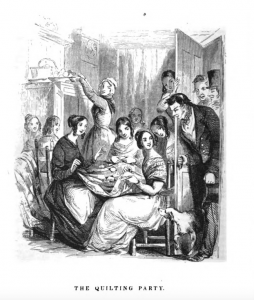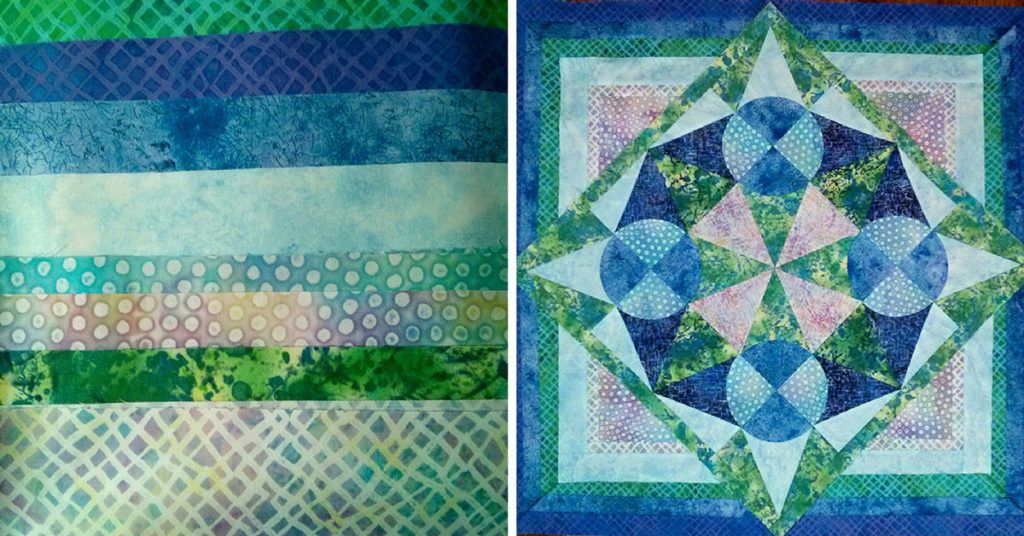Saturday Morning Quilt Break: September in Quilt History | Quilty Pleasures Blog

Quilters are part of an unbroken tradition stretching back hundreds of years, and although many quilts were made by women who never signed their work, quilt history is rich with interesting stories. Here are just a few quilty things that happened during the month of September.
1849: “The Quilting Party,” a short story by T.S. Arthur, was published in Godey’s Lady’s Book, which was the most popular women’s periodical of its day.
The story begins as such:
Our young ladies of the present generation know little of the mysteries of “Irish chain,” “rising star,” “block work,” or “Job’s trouble,” and would be as likely to mistake a set of quilting frames for clothes poles as for anything else. It was different in our younger days. Half a dozen handsome patchwork quilts were as indispensable then as a marriage potion; quite as much so as a piano or guitar is at present. And the quilting party was equally indicative of the coming-out and being “in the market,” as the fashionable gatherings together of the times that be.
Although the narrator goes on to say that “we do not belong to the class who believe that society is retrograding because everything is not as it was in the earlier days,” this story of The Girl Who Got Away has a distinctly wistful tone.
In it, the narrator and a friend attend the first quilting party hosted by Amy Willing, “who was the favorite of all” in the village. When they and other suitors arrive at Amy’s cottage, they find it “full of girls, who were busy in binding Amy’s quilt, which was already out of the frame, and getting all ready for the evening’s sport.” Before long the half-bound quilt is put away and the kissing games (which “was then a fashionable amusement”) begin.
Needless to say, the narrator is crushed when he learns after the party that Amy is engaged to someone else despite having been the object of her attention that evening.
Ah, well! More than twenty years have passed since then. The quiltings, the corn huskings, the merry-makings in the village of M___ are not forgotten. Nor is Amy Willing and the party forgotten, as this brief sketch assuredly testifies. Twenty years. How many changes have come in that period!
Nostalgia: it ain’t what it used to be, right?
1885: The New York Times reported on September 25 that Mrs. N.W. Carswell of Waterbury, Connecticut, had “just completed a curious bit of work which she calls a Grand Army quilt” that incorporated bits of silk from both the North and South. It’s an impressive quilt: the center was composed of 49 appliqued and embroidered blocks representing various flags, corps badges and other images. The blocks were sashed with black satin strips “worked” with 151 stars, while the border included a variety of historical U.S. flags alternating with different military motifs such as axes, a knapsack, drums, crossed muskets, sabres and flowers. To top it off, the edging included the name, term of service and date of death of every U.S. president to that point. Fortunately for us, this quilt is now in the collection of the Mattatuck Museum in Waterbury; click here to see photos of the quilt .
1977: Kay McFarland (1935-2015) became the first woman appointed to the Kansas Supreme Court on September 19, 1977, and became the state’s first female chief justice September 1, 1995. While studying law at Washburn University in the early 1960s, McFarland funded her tuition by selling “old-fashioned” quilts made by Kansas quiltmakers via mail order. She was also apparently an expert seamstress and quilter, and an estate sale held after she died included quilts and afghans she made along with a “huge collection of fabric!!” according to the public notice.
1994: Dorothy Kinnicutt Parish, known professionally as Sister Parish, died September 8. One of the leading interior decorators of the 1970s and 1980s, Parish began decorating for friends in the 1930s. She went on to work for wealthy families such as the Rockefellers and the Vanderbilts, and worked briefly in 1961 for Jacqueline Kennedy on refurbishing rooms in the White House. Parish is thought to have originated the American country style of decorating in the 1960s, incorporating traditional handicrafts, including patchwork quilts, into upscale rooms, and working with quilters from Selma, Alabama, to develop patchwork goods.
This is just a sampling of notable things that have happened in Septembers past that are of interest to quilters (click here to read about some others). Well, they’re of interest to me, at least, but I am a self-described big nerd when it comes to things like this. Leave me a comment to let me know if “This Month in Quilt History” tidbits like these interest you or not; we have plenty of resources here and I would love to share more of what we’ve compiled!
Have a great week,
Mary Kate






Join the Conversation!